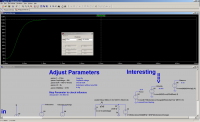
High power EM projectile launcher
Kizmo, Tue Apr 07 2015, 09:49PMIt has been a while since I have done anything that is related to good old pops and bangs.
So here it goes: I want to see practical limits of "conventional" ring launcher and possibly something else in future. Starter setup is following: (note: this is just a small scale prototype
 )
)
12x 400VDC 6800µF nominal, about 5850µF measured S+M brand (Siemens, Epcos) capacitors. These have been sitting around and collecting dust for couple years so i gave them good cleanup and reform/leakage current test. All 12 turned out to be winners leaking less than 1mA at full rated voltage after ~5 minutes.
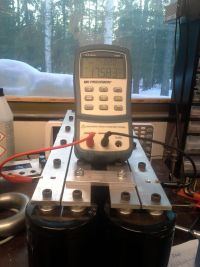
Bank was wired in 2s6p configuration. Busbars are 6x30mm 6061 aluminum. 17.583mF at 800V means whopping 5600J of electrical energy. And if we are naughty and charge these capacitors right to the surge voltage rating (440V), 6800J
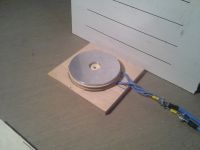
2nd iteration of the work coil. About 10 turns of two parallel 2½mm^2 copper wires. Measures 10.6µH. Coil is heavily epoxied between two plywood disks and so far has been holding together ok. Here you can see the projectile I ended up using. It is cut from 6mm aluminum plate, 128mm outer diameter and 30mm inner diameter. Disk weights about 192grams.
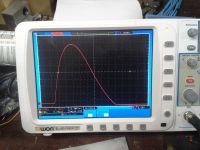
800V shot with projectile. Current transformer ratio is 0.005V/A so 81.60V translates into 16.32kA
The bank is solid state switched of course. SCR used is single semikron SKKH330/16E (datasheet:
 )
)I ran out of time with this setup and 4kJ was about maximum i wanted to try without proper projectile catcher. As you see the stack of old bed sheets does not work all that well at these energies :D (before bed sheet stack i had piece of foam mattress taped over the scale and the disk went right through it..)
Couple poor quality videos:
4kJ test, measured disk speed was 60m/s. Kinetic energy 346J and the efficiency was 8.65%. And yes, the disk with bed sheets did hit the ceiling pretty hard..
Casio EX-F1 pro 1200fps is used for speed measurement
Much more to come in near future. I have several work coils under work right now as well as different projectiles. With this coil it looked like the thick 6mm disk gave me by far best efficiency (but not all that great yet..).
UPDATE 09/02/2016
High speed camera is not ideal for measuring disk velocity. So I made a simple beam break chronograph.
Phototransistors with black plastic housings
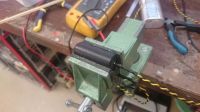
650nm lasers
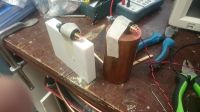
Small test by whacking beams with wooden stick. Beam to beam distance was 25mm so 0.025m / 524*10^-6s = 47.70m/s
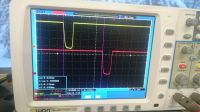
Frame i made from scrap metal. Its very rigid and lasers keep their alignment even if I stand on the frame.
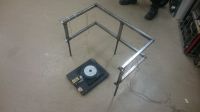
Re: High power EM projectile launcher
Kizmo, Tue Apr 07 2015, 10:00PM
Reserved for future updates -
Kizmo, Tue Apr 07 2015, 10:00PM
Reserved for future updates -
Re: High power EM projectile launcher
Signification, Wed Apr 08 2015, 11:52AM
...just started looking into your post details, and I will post some of my calculations when I have more time--right now, just a couple of things:
*1) Can you post the HWFM current according to your scope waveform?--I would like to check with what I get.
*2) concerning disc thickness, have you considered equations from parameters such as resistivity of disc and dB/dt values. This should give estimates of EDDY current and SKIN effect for determining field penetration into the disc for your parameters--in magnetoforming this is useful in calculating minimum disc thickness to 'contain' the field for greater efficiency i.e. this reveals min thickness, below which, the field lines would penetrate the disc--thus being wasted in 'lifting force'. Also, for thicker discs, the weight would be excessive. BTW, magnetoforming is done in a vacuum to eliminate serious air effects.
One more thing--just out of curiosity: If, somehow, the disc could be made to launch laterally, thus minimizing air resistance,(somewhat like a frisbee), what would be your guess as to the increased efficiency (or speed) as opposed to the common configuration which MAXIMIZES air drag?
Signification, Wed Apr 08 2015, 11:52AM
...just started looking into your post details, and I will post some of my calculations when I have more time--right now, just a couple of things:
*1) Can you post the HWFM current according to your scope waveform?--I would like to check with what I get.
*2) concerning disc thickness, have you considered equations from parameters such as resistivity of disc and dB/dt values. This should give estimates of EDDY current and SKIN effect for determining field penetration into the disc for your parameters--in magnetoforming this is useful in calculating minimum disc thickness to 'contain' the field for greater efficiency i.e. this reveals min thickness, below which, the field lines would penetrate the disc--thus being wasted in 'lifting force'. Also, for thicker discs, the weight would be excessive. BTW, magnetoforming is done in a vacuum to eliminate serious air effects.
One more thing--just out of curiosity: If, somehow, the disc could be made to launch laterally, thus minimizing air resistance,(somewhat like a frisbee), what would be your guess as to the increased efficiency (or speed) as opposed to the common configuration which MAXIMIZES air drag?
Re: High power EM projectile launcher
Kizmo, Wed Apr 08 2015, 12:25PM
1. Yes i can, but not untill next weekend
2. Not really, i can machine and test different size disks quicker than i can solve all that math/physics involved. If you are capable of doing that i will be more than happy to see how well theory backs up my experiments :)
Afaik i have seen disk launchers like this that do indeed launch disks like a frisbee. Someone on this forum even? But if my memory serves me right the efficiency of such launcher was somewhat poor.
My projects usually involve brute force instead of optimized design anyways. Eventually this project will be stepped towards several 10s of kJs..
Eventually this project will be stepped towards several 10s of kJs.. 
Kizmo, Wed Apr 08 2015, 12:25PM
Signification wrote ...
...just started looking into your post details, and I will post some of my calculations when I have more time--right now, just a couple of things:
*1) Can you post the HWFM current according to your scope waveform?--I would like to check with what I get.
*2) concerning disc thickness, have you considered equations from parameters such as resistivity of disc and dB/dt values. This should give estimates of EDDY current and SKIN effect for determining field penetration into the disc for your parameters--in magnetoforming this is useful in calculating minimum disc thickness to 'contain' the field for greater efficiency i.e. this reveals min thickness, below which, the field lines would penetrate the disc--thus being wasted in 'lifting force'. Also, for thicker discs, the weight would be excessive. BTW, magnetoforming is done in a vacuum to eliminate serious air effects.
One more thing--just out of curiosity: If, somehow, the disc could be made to launch laterally, thus minimizing air resistance,(somewhat like a frisbee), what would be your guess as to the increased efficiency (or speed) as opposed to the common configuration which MAXIMIZES air drag?
...just started looking into your post details, and I will post some of my calculations when I have more time--right now, just a couple of things:
*1) Can you post the HWFM current according to your scope waveform?--I would like to check with what I get.
*2) concerning disc thickness, have you considered equations from parameters such as resistivity of disc and dB/dt values. This should give estimates of EDDY current and SKIN effect for determining field penetration into the disc for your parameters--in magnetoforming this is useful in calculating minimum disc thickness to 'contain' the field for greater efficiency i.e. this reveals min thickness, below which, the field lines would penetrate the disc--thus being wasted in 'lifting force'. Also, for thicker discs, the weight would be excessive. BTW, magnetoforming is done in a vacuum to eliminate serious air effects.
One more thing--just out of curiosity: If, somehow, the disc could be made to launch laterally, thus minimizing air resistance,(somewhat like a frisbee), what would be your guess as to the increased efficiency (or speed) as opposed to the common configuration which MAXIMIZES air drag?
1. Yes i can, but not untill next weekend
2. Not really, i can machine and test different size disks quicker than i can solve all that math/physics involved. If you are capable of doing that i will be more than happy to see how well theory backs up my experiments :)
Afaik i have seen disk launchers like this that do indeed launch disks like a frisbee. Someone on this forum even? But if my memory serves me right the efficiency of such launcher was somewhat poor.
My projects usually involve brute force instead of optimized design anyways.
 Eventually this project will be stepped towards several 10s of kJs..
Eventually this project will be stepped towards several 10s of kJs.. 
Re: High power EM projectile launcher
loneoceans, Thu Apr 09 2015, 09:27PM
That looks like a fun project with a nice bank of capacitors. I'm a little bit concerned about your capacitor bus bars being so close together though
loneoceans, Thu Apr 09 2015, 09:27PM
That looks like a fun project with a nice bank of capacitors. I'm a little bit concerned about your capacitor bus bars being so close together though

Re: High power EM projectile launcher
Signification, Thu Apr 09 2015, 09:50PM
Yeah, I was wondering about those close bus-bars too! Was this design originally for some other special Low-L power project--a huge IGBT perhaps? You didn't design it this way for your launcher did you?
Does it make a significant different to place them *this* close? I ask because I have an application that will require very low inductance--an IGBT-based induction heater as I learn more about them.
Signification, Thu Apr 09 2015, 09:50PM
loneoceans wrote ...
That looks like a fun project with a nice bank of capacitors. I'm a little bit concerned about your capacitor bus bars being so close together though
That looks like a fun project with a nice bank of capacitors. I'm a little bit concerned about your capacitor bus bars being so close together though

Yeah, I was wondering about those close bus-bars too! Was this design originally for some other special Low-L power project--a huge IGBT perhaps? You didn't design it this way for your launcher did you?
Does it make a significant different to place them *this* close? I ask because I have an application that will require very low inductance--an IGBT-based induction heater as I learn more about them.
Re: High power EM projectile launcher
loneoceans, Thu Apr 09 2015, 10:32PM
A laminated bus bar is the way to go for low-L bus projects like induction heaters, and they will have something like 1 or 2 orders of magnitude less bus inductance than even this setup with the bars so close together.
Kizmo, it might be fun to try making a linear ring launcher just for fun as well! If you make the ring small you can get some really amazing velocities, but I suspect the efficiency will be much reduced and the stress on your capacitors be increased.
loneoceans, Thu Apr 09 2015, 10:32PM
Signification wrote ...
Yeah, I was wondering about those close bus-bars too! Was this design originally for some other special Low-L power project--a huge IGBT perhaps? You didn't design it this way for your launcher did you?
Does it make a significant different to place them *this* close? I ask because I have an application that will require very low inductance--an IGBT-based induction heater as I learn more about them.
Yeah, I was wondering about those close bus-bars too! Was this design originally for some other special Low-L power project--a huge IGBT perhaps? You didn't design it this way for your launcher did you?
Does it make a significant different to place them *this* close? I ask because I have an application that will require very low inductance--an IGBT-based induction heater as I learn more about them.
A laminated bus bar is the way to go for low-L bus projects like induction heaters, and they will have something like 1 or 2 orders of magnitude less bus inductance than even this setup with the bars so close together.
Kizmo, it might be fun to try making a linear ring launcher just for fun as well! If you make the ring small you can get some really amazing velocities, but I suspect the efficiency will be much reduced and the stress on your capacitors be increased.
Re: High power EM projectile launcher
Kizmo, Fri Apr 10 2015, 05:57AM
Busbars being close together is just a fluke. I used 30mm wide bars that i drilled for another application years ago. They just happened to be right shape and size to work with minimum effort :)
Air gap between rails is about 2mm, which is fine for 400V. Im always open for ideas or suggestions so keep them coming. And im not too worried about stressing these junk capacitors. I have so many of these its not even funny. Only downside is that one shorted capacirtor in bank of many capacitors in parallel results explosive short circuit clearing

Thing like that happened couple years ago, single 420V 3300µ capacitor got hit by 12kJ while charging. It was mighty bang and capacitor element got launched like ETG projectile
Kizmo, Fri Apr 10 2015, 05:57AM
Busbars being close together is just a fluke. I used 30mm wide bars that i drilled for another application years ago. They just happened to be right shape and size to work with minimum effort :)
Air gap between rails is about 2mm, which is fine for 400V. Im always open for ideas or suggestions so keep them coming. And im not too worried about stressing these junk capacitors. I have so many of these its not even funny. Only downside is that one shorted capacirtor in bank of many capacitors in parallel results explosive short circuit clearing


Thing like that happened couple years ago, single 420V 3300µ capacitor got hit by 12kJ while charging. It was mighty bang and capacitor element got launched like ETG projectile

Re: High power EM projectile launcher
klugesmith, Fri Apr 10 2015, 06:17AM


 Attached picture is from first link; second link gives some history.
Attached picture is from first link; second link gives some history.
I was about to say that Kizmo's busbar spacing looks plenty wide for 800 volts. Even more so for 400 V, which is almost below the threshold for jumping across any air gap. Unless you drop a metal object on them.
As loneoceans said, interconnection inductance would be much lower if the busbars were face to face, separated by a thin insulating spacer, instead of edge to edge. Of course that maximizes the Lorentz force trying to push them apart.
klugesmith, Fri Apr 10 2015, 06:17AM
Signification wrote ...
If, somehow, the disc could be made to launch laterally, thus minimizing air resistance,(somewhat like a frisbee), what would be your guess as to the increased efficiency (or speed) as opposed to the common configuration which MAXIMIZES air drag?
Who remembers "tracer" disk guns from the 1970's?If, somehow, the disc could be made to launch laterally, thus minimizing air resistance,(somewhat like a frisbee), what would be your guess as to the increased efficiency (or speed) as opposed to the common configuration which MAXIMIZES air drag?


 Attached picture is from first link; second link gives some history.
Attached picture is from first link; second link gives some history.I was about to say that Kizmo's busbar spacing looks plenty wide for 800 volts. Even more so for 400 V, which is almost below the threshold for jumping across any air gap. Unless you drop a metal object on them.
As loneoceans said, interconnection inductance would be much lower if the busbars were face to face, separated by a thin insulating spacer, instead of edge to edge. Of course that maximizes the Lorentz force trying to push them apart.
Re: High power EM projectile launcher
Signification, Sun Apr 12 2015, 04:57PM
Ah...the Star Trek disk shooter--Oh YEAH! In fact, not to long ago I found one of the discs in the attic under some insulation!
But my favorite was that Whamo air gun (can't recall the name) that you cocked by pulling back a stiff rubber membrane--it then fired a vortex through the air. I got it off ebay as broken and finally managed to fix it. By far the hardest part of the repair was just getting through the rivets and inside the gun. To my great surprise, the rubber disc was not rotten--in fact, like new!...don't make 'em like that anymore-for sure. I think they were banned due to kids injuring their eardrums with point blank shots! They were recently replaced by a big clumsy thing with some sort of air bag--comparatively, junk.
Around then, I remember spring-twist driven guns that fired flying propellers--always getting stuck in trees!
Signification, Sun Apr 12 2015, 04:57PM
Ah...the Star Trek disk shooter--Oh YEAH! In fact, not to long ago I found one of the discs in the attic under some insulation!
But my favorite was that Whamo air gun (can't recall the name) that you cocked by pulling back a stiff rubber membrane--it then fired a vortex through the air. I got it off ebay as broken and finally managed to fix it. By far the hardest part of the repair was just getting through the rivets and inside the gun. To my great surprise, the rubber disc was not rotten--in fact, like new!...don't make 'em like that anymore-for sure. I think they were banned due to kids injuring their eardrums with point blank shots! They were recently replaced by a big clumsy thing with some sort of air bag--comparatively, junk.
Around then, I remember spring-twist driven guns that fired flying propellers--always getting stuck in trees!
Re: High power EM projectile launcher
Kizmo, Sun Apr 12 2015, 09:05PM
Todays experiments:
several shots at 800VDC 5.6kJ
First shot:
- 10.6µH coil, 192g disk
- Measured velocity over 800mm travel 60m/s
- Kinetic energy 346J, efficiency 6.2%
Second shot:
- 10.6µH coil, 192g disk, 85g additional non metallic load on the disk
- Measured velocity over 800mm travel 60m/s
- Kinetic energy 497J, efficinecy 8.9%
I also did couple shots with 40µH coil but performance was much worse. I think next coil i will try will be around 8µH and made from super heavy wire. Current coil is made from two parallel 2½mm^2 copper wires and it gets rather warm after couple shots.
Right now 60m/s seems to be difficult to beat, but funny thing is that i can add quit a lot of weight in the aluminum disk and it still flies 60m/s
Kizmo, Sun Apr 12 2015, 09:05PM
Todays experiments:
several shots at 800VDC 5.6kJ
First shot:
- 10.6µH coil, 192g disk
- Measured velocity over 800mm travel 60m/s
- Kinetic energy 346J, efficiency 6.2%
Second shot:
- 10.6µH coil, 192g disk, 85g additional non metallic load on the disk
- Measured velocity over 800mm travel 60m/s
- Kinetic energy 497J, efficinecy 8.9%
I also did couple shots with 40µH coil but performance was much worse. I think next coil i will try will be around 8µH and made from super heavy wire. Current coil is made from two parallel 2½mm^2 copper wires and it gets rather warm after couple shots.
Right now 60m/s seems to be difficult to beat, but funny thing is that i can add quit a lot of weight in the aluminum disk and it still flies 60m/s

Re: High power EM projectile launcher
hen918, Mon Apr 13 2015, 05:59PM
what do you use to dump the back EMF? some big-ass diodes?
hen918, Mon Apr 13 2015, 05:59PM
what do you use to dump the back EMF? some big-ass diodes?
Re: High power EM projectile launcher
Kizmo, Mon Apr 13 2015, 06:14PM
(well, not true. I dont disconnect my charger and it has 50R series resistance on DC side so any negative voltage will be bled away by the rectifier bridge)
I did some more testing today and find out interesting thing: My chinese scale was reading wrong from the beginning. The 125g disk was actually 192g and so on I have updated earlier posts with correct numbers
I have updated earlier posts with correct numbers
Also made 390g disk:
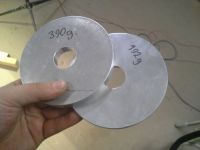
192g disk at 4kJ in, 346J to kinetic energy
Kizmo, Mon Apr 13 2015, 06:14PM
hen918 wrote ...
what do you use to dump the back EMF? some big-ass diodes?
Nothing. :) what do you use to dump the back EMF? some big-ass diodes?
(well, not true. I dont disconnect my charger and it has 50R series resistance on DC side so any negative voltage will be bled away by the rectifier bridge)
I did some more testing today and find out interesting thing: My chinese scale was reading wrong from the beginning. The 125g disk was actually 192g and so on
 I have updated earlier posts with correct numbers
I have updated earlier posts with correct numbersAlso made 390g disk:

192g disk at 4kJ in, 346J to kinetic energy
Re: High power EM projectile launcher
Uspring, Tue Apr 14 2015, 08:53AM
Uspring, Tue Apr 14 2015, 08:53AM
Right now 60m/s seems to be difficult to beat, but funny thing is that i can add quit a lot of weight in the aluminum disk and it still flies 60m/sPossibly the disk takes off long before the field has reached max. More mass implies slower takeoff and a perhaps a higher field before the disk leaves the range of the field. That would also explain the lower performance for your larger inductance coils, since there the field builds up even slower. But the lower performance might also be due to the larger resistance.
Re: High power EM projectile launcher
Hydron, Tue Apr 14 2015, 12:54PM
Chucking the coil in some liquid nitrogen could be interesting, dramatically lowers the resistance.
Hydron, Tue Apr 14 2015, 12:54PM
Chucking the coil in some liquid nitrogen could be interesting, dramatically lowers the resistance.
Re: High power EM projectile launcher
Kizmo, Tue Apr 14 2015, 04:24PM
I am planning to build about 10µH coil that is wound with copper flat bar or perhaps flattened water pipe.
Kizmo, Tue Apr 14 2015, 04:24PM
I am planning to build about 10µH coil that is wound with copper flat bar or perhaps flattened water pipe.
Re: High power EM projectile launcher
Sulaiman, Tue Apr 14 2015, 04:52PM
from the few small experiments that I have done
and noting performance of various EM launchers
it seems to me that increasing mass usually increases efficiency
with two problems;
great lumps of metal with lots of momentum as well as energy
unimpressive projectile speed.
I can speculate, but I don't actually KNOW why this is,
one of those laws of nature things ?
Sulaiman, Tue Apr 14 2015, 04:52PM
from the few small experiments that I have done
and noting performance of various EM launchers
it seems to me that increasing mass usually increases efficiency
with two problems;
great lumps of metal with lots of momentum as well as energy
unimpressive projectile speed.
I can speculate, but I don't actually KNOW why this is,
one of those laws of nature things ?
Re: High power EM projectile launcher
hen918, Tue Apr 14 2015, 05:02PM
I can recommend flattened water-pipe. I used micro-bore pipe, wound in a spiral, for my can crusher / launcher. It worked well un-enclosed, but I noticed it was getting more bent and out of line every shot, so I 3D printed a surround for it and epoxied it in. Since then it's been on the back-burner and I haven't gotten around to removing the thick layer of plastic covering the coil.
hen918, Tue Apr 14 2015, 05:02PM
Kizmo wrote ...
I am planning to build about 10µH coil that is wound with copper flat bar or perhaps flattened water pipe.
I am planning to build about 10µH coil that is wound with copper flat bar or perhaps flattened water pipe.
I can recommend flattened water-pipe. I used micro-bore pipe, wound in a spiral, for my can crusher / launcher. It worked well un-enclosed, but I noticed it was getting more bent and out of line every shot, so I 3D printed a surround for it and epoxied it in. Since then it's been on the back-burner and I haven't gotten around to removing the thick layer of plastic covering the coil.
Re: High power EM projectile launcher
Kizmo, Tue Apr 14 2015, 05:18PM
It is still very impressive bang.. kind of scary
I managed to hit c-clamp that was holding my projectile stopper together. Disk was stopped but the clamp got launched and it smashed ccfl tube from ceiling light fixture
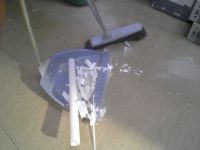
Kizmo, Tue Apr 14 2015, 05:18PM
Sulaiman wrote ...
great lumps of metal with lots of momentum as well as energy
unimpressive projectile speed,
more like artillery than small arms.
great lumps of metal with lots of momentum as well as energy
unimpressive projectile speed,
more like artillery than small arms.
It is still very impressive bang.. kind of scary

I managed to hit c-clamp that was holding my projectile stopper together. Disk was stopped but the clamp got launched and it smashed ccfl tube from ceiling light fixture

Re: High power EM projectile launcher
Ash Small, Tue Apr 14 2015, 08:23PM
As Udo pointed out, if it's heavier, it will stay in the field being accelerated for longer.
I assume that while it is in the 'field' it is adding to the inductance, The more mass, the greater the inductance, and the longer the pulse lasts, also, a light disc will leave the field (and stop being accelerated) quicker, so won't be accelerated for as long as a heavier disc.
Maybe the 'law of nature' is to do with a heavier disc being accelerated for longer, so extra mass just means it's accelerated for longer, therefore mass has no bearing on velocity?
Obviously this would only hold true up to a certain point, the point I'm making is that as mass increases, efficiency increases, up to a point.
Ash Small, Tue Apr 14 2015, 08:23PM
Sulaiman wrote ...
.it seems to me that increasing mass usually increases efficiency
.
I can speculate, but I don't actually KNOW why this is,
one of those laws of nature things ?
.it seems to me that increasing mass usually increases efficiency
.
I can speculate, but I don't actually KNOW why this is,
one of those laws of nature things ?
As Udo pointed out, if it's heavier, it will stay in the field being accelerated for longer.
I assume that while it is in the 'field' it is adding to the inductance, The more mass, the greater the inductance, and the longer the pulse lasts, also, a light disc will leave the field (and stop being accelerated) quicker, so won't be accelerated for as long as a heavier disc.
Maybe the 'law of nature' is to do with a heavier disc being accelerated for longer, so extra mass just means it's accelerated for longer, therefore mass has no bearing on velocity?
Obviously this would only hold true up to a certain point, the point I'm making is that as mass increases, efficiency increases, up to a point.
Re: High power EM projectile launcher
Kizmo, Sat Apr 18 2015, 10:42AM
I will re arrange the capacitor bank to be 1200V and reduce the work coil inductance. That should cut the pulse length to half and increase amplitude a lot :)
Kizmo, Sat Apr 18 2015, 10:42AM
I will re arrange the capacitor bank to be 1200V and reduce the work coil inductance. That should cut the pulse length to half and increase amplitude a lot :)
Re: High power EM projectile launcher
hen918, Sat Apr 18 2015, 02:15PM
1200v was (is) my goal. seems a nice balance between enough voltage to have a large dv/dt but not so much as to have complex insulation arrangements. It also comes under the rating of my 300A 1600V stud thyristor.
hen918, Sat Apr 18 2015, 02:15PM
Kizmo wrote ...
I will re arrange the capacitor bank to be 1200V and reduce the work coil inductance. That should cut the pulse length to half and increase amplitude a lot :)
I will re arrange the capacitor bank to be 1200V and reduce the work coil inductance. That should cut the pulse length to half and increase amplitude a lot :)
1200v was (is) my goal. seems a nice balance between enough voltage to have a large dv/dt but not so much as to have complex insulation arrangements. It also comes under the rating of my 300A 1600V stud thyristor.
Re: High power EM projectile launcher
Kizmo, Sat Apr 18 2015, 06:58PM
So here are some numbers:
I reconfigured the capacitor bank from 2s8p to 4s3p Now the bank is rated for 1600V 4361µF 17mOhm ESR (capacitance and ESR were measured)
First test shot with high speed camera, 1600V 5600Joules and 192g aluminum disk.
- Measured speed 80m/s over the distance of 80cm
- Kinetic energy 614J
- Efficiency 10.9%
- Peak current 20.3kA, current rise time about 200µs
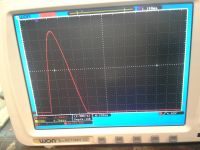
(From other shot, but the waveform shape is same)
As you can see the current rise is now much much faster and it does show.
Interestingly i fired the 390g disk and it was travelling at 54m/s (569J kinetic, 10.1% efficiency) so this time around heavier disk was not better.
But the 390g disk did one thing: it hit the projectile stopper contraption so hard that one of the sand bags i used exploded and for a split second there was raining sand in my hobby corner... what a mess
Kizmo, Sat Apr 18 2015, 06:58PM
So here are some numbers:
I reconfigured the capacitor bank from 2s8p to 4s3p Now the bank is rated for 1600V 4361µF 17mOhm ESR (capacitance and ESR were measured)
First test shot with high speed camera, 1600V 5600Joules and 192g aluminum disk.
- Measured speed 80m/s over the distance of 80cm
- Kinetic energy 614J
- Efficiency 10.9%
- Peak current 20.3kA, current rise time about 200µs

(From other shot, but the waveform shape is same)
As you can see the current rise is now much much faster and it does show.
Interestingly i fired the 390g disk and it was travelling at 54m/s (569J kinetic, 10.1% efficiency) so this time around heavier disk was not better.
But the 390g disk did one thing: it hit the projectile stopper contraption so hard that one of the sand bags i used exploded and for a split second there was raining sand in my hobby corner... what a mess

Re: High power EM projectile launcher
Ash Small, Sat Apr 18 2015, 09:39PM
It may be worth adding a small amount of extra weight to the disc. If efficiency doesn't improve, then remove a small amount from the disc.
You've probably reached this conclusion anyway
Ash Small, Sat Apr 18 2015, 09:39PM
It may be worth adding a small amount of extra weight to the disc. If efficiency doesn't improve, then remove a small amount from the disc.
You've probably reached this conclusion anyway

Re: High power EM projectile launcher
Kizmo, Sun Apr 19 2015, 05:48PM
Lost the disk again
Kizmo, Sun Apr 19 2015, 05:48PM
Lost the disk again

Re: High power EM projectile launcher
Mads Barnkob, Tue Apr 21 2015, 06:13AM
Do you have any pictures of your SCR setup?
Is your work coil just potted in epoxy between two pieces of wood or did you do something extra to keep it holding together for so many high power shots?
*biiiiiiing* and looking forward to the scaled up version :)
Mads Barnkob, Tue Apr 21 2015, 06:13AM
Do you have any pictures of your SCR setup?
Is your work coil just potted in epoxy between two pieces of wood or did you do something extra to keep it holding together for so many high power shots?
*biiiiiiing* and looking forward to the scaled up version :)
Re: High power EM projectile launcher
Kizmo, Tue Apr 21 2015, 03:55PM

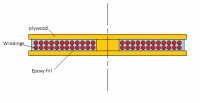
Quick drawing of the current coil. So far it has stayed together ok up to 5.9kJ 20kA. Mabe 20-30 shots at full energy and i cannot find any signs of epoxy cracking.
I just ordered 12 meters of 5x30mm aluminum flat for constructing the next capacitor bank...
Kizmo, Tue Apr 21 2015, 03:55PM
Mads Barnkob wrote ...
Do you have any pictures of your SCR setup?
Is your work coil just potted in epoxy between two pieces of wood or did you do something extra to keep it holding together for so many high power shots?
*biiiiiiing* and looking forward to the scaled up version :)
Do you have any pictures of your SCR setup?
Is your work coil just potted in epoxy between two pieces of wood or did you do something extra to keep it holding together for so many high power shots?
*biiiiiiing* and looking forward to the scaled up version :)


Quick drawing of the current coil. So far it has stayed together ok up to 5.9kJ 20kA. Mabe 20-30 shots at full energy and i cannot find any signs of epoxy cracking.
I just ordered 12 meters of 5x30mm aluminum flat for constructing the next capacitor bank...

Re: High power EM projectile launcher
RateReducer, Tue Apr 21 2015, 04:29PM
You got some serious power here! Nice!
Experimenting with an ETG i noticed that the capacitance of the electrolytic capacitors decreases more and more during shooting. Could you measure the capacitance once again to do a comparison?
Would be interesting to see if those big caps can handle those really high currents without wear.
RateReducer, Tue Apr 21 2015, 04:29PM
You got some serious power here! Nice!

Experimenting with an ETG i noticed that the capacitance of the electrolytic capacitors decreases more and more during shooting. Could you measure the capacitance once again to do a comparison?
Would be interesting to see if those big caps can handle those really high currents without wear.
Re: High power EM projectile launcher
Kizmo, Tue Apr 21 2015, 04:32PM
Sure. I have the capacitance of each capacitor written down from when i reformed them :)
Kizmo, Tue Apr 21 2015, 04:32PM
Sure. I have the capacitance of each capacitor written down from when i reformed them :)
Re: High power EM projectile launcher
Kizmo, Sat Apr 25 2015, 06:33AM
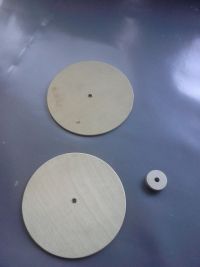
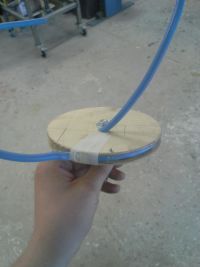
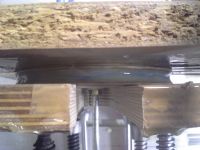
Made another launching coil. Old coil was getting hot after several shots at 5.6kJ. This one is wound with 20mm^2 copper cable and measures about 4.6µH. Lower inductance should give faster rise time :)
Kizmo, Sat Apr 25 2015, 06:33AM



Made another launching coil. Old coil was getting hot after several shots at 5.6kJ. This one is wound with 20mm^2 copper cable and measures about 4.6µH. Lower inductance should give faster rise time :)
Re: High power EM projectile launcher
benbmw, Sat Nov 28 2015, 08:41PM
How did that new coil work? I am currently constructing a ring launcher and i have some 2/0 cable that I am using to make a 4 turn coil that is about 5-6 inches in diameter. This is my first ring launcher and I wasn't sure if this coil would perform well. I have some 8 gauge wire that I could also use. Which coil would work best in your opinion? I know the 2/0 coil will have a lower inductance which allow higher peak currents, but will the smaller number of turns(only 4) compared to a coil with 8 gauge wire(around 10) hurt the strength of the magnetic field?
Thanks for the info,
Ben
benbmw, Sat Nov 28 2015, 08:41PM
How did that new coil work? I am currently constructing a ring launcher and i have some 2/0 cable that I am using to make a 4 turn coil that is about 5-6 inches in diameter. This is my first ring launcher and I wasn't sure if this coil would perform well. I have some 8 gauge wire that I could also use. Which coil would work best in your opinion? I know the 2/0 coil will have a lower inductance which allow higher peak currents, but will the smaller number of turns(only 4) compared to a coil with 8 gauge wire(around 10) hurt the strength of the magnetic field?
Thanks for the info,
Ben
Re: High power EM projectile launcher
hen918, Sun Nov 29 2015, 04:55PM
That depends on what capacitors / switching device you are planning to use, although I think either way, 4 turns will lead to a greater proportion of leakage induction, wasting a lot of energy not coupled to the projectile as well as the lower resistance putting A LOT of stress on your caps/switch gear.
hen918, Sun Nov 29 2015, 04:55PM
benbmw wrote ...
How did that new coil work? I am currently constructing a ring launcher and i have some 2/0 cable that I am using to make a 4 turn coil that is about 5-6 inches in diameter. This is my first ring launcher and I wasn't sure if this coil would perform well. I have some 8 gauge wire that I could also use. Which coil would work best in your opinion? I know the 2/0 coil will have a lower inductance which allow higher peak currents, but will the smaller number of turns(only 4) compared to a coil with 8 gauge wire(around 10) hurt the strength of the magnetic field?
Thanks for the info,
Ben
How did that new coil work? I am currently constructing a ring launcher and i have some 2/0 cable that I am using to make a 4 turn coil that is about 5-6 inches in diameter. This is my first ring launcher and I wasn't sure if this coil would perform well. I have some 8 gauge wire that I could also use. Which coil would work best in your opinion? I know the 2/0 coil will have a lower inductance which allow higher peak currents, but will the smaller number of turns(only 4) compared to a coil with 8 gauge wire(around 10) hurt the strength of the magnetic field?
Thanks for the info,
Ben
That depends on what capacitors / switching device you are planning to use, although I think either way, 4 turns will lead to a greater proportion of leakage induction, wasting a lot of energy not coupled to the projectile as well as the lower resistance putting A LOT of stress on your caps/switch gear.
Re: High power EM projectile launcher
Signification, Sun Dec 06 2015, 09:35PM
Will not the way of the <=4-turn, FASTest pulse, quicker discharge of capacitor energy (max if tuned properly), keep the disc 'inside' the -energy- field for much more field-absorption, and perhaps 'capturing' all, or most, of the B-field, just before (or just after) it transverses the disk thickness (as actually calculated in magneto-forming) during the 'lift-off / flux penetration' race; tend just a teeny-tiny "bit-more" to reach the moon?
Also, my gut tells me, there -must- be something, -even trivial-, that can be done to the disk (or launcher), so that it is not at the **absolute maximum** worst launching path WRT the atmosphere. It's *ALL* those darn air molecules hitting so -fast- and -perpendicularly- at just the wrong time. Just a thought...I am GREATLY interested in disk-launching and have, somewhat recently, put considerable thought into frisbee-type launching (thrust and spin), disks from these Aluminum types, down to coins. The energy and power are there--you just know it--if you ever held a properly-shrunk quarter!!!
Signification, Sun Dec 06 2015, 09:35PM
Will not the way of the <=4-turn, FASTest pulse, quicker discharge of capacitor energy (max if tuned properly), keep the disc 'inside' the -energy- field for much more field-absorption, and perhaps 'capturing' all, or most, of the B-field, just before (or just after) it transverses the disk thickness (as actually calculated in magneto-forming) during the 'lift-off / flux penetration' race; tend just a teeny-tiny "bit-more" to reach the moon?
Also, my gut tells me, there -must- be something, -even trivial-, that can be done to the disk (or launcher), so that it is not at the **absolute maximum** worst launching path WRT the atmosphere. It's *ALL* those darn air molecules hitting so -fast- and -perpendicularly- at just the wrong time. Just a thought...I am GREATLY interested in disk-launching and have, somewhat recently, put considerable thought into frisbee-type launching (thrust and spin), disks from these Aluminum types, down to coins. The energy and power are there--you just know it--if you ever held a properly-shrunk quarter!!!
Re: High power EM projectile launcher
hen918, Mon Dec 07 2015, 09:47PM
By that reasoning a 1 turn coil ought to be the best; it isn't because the wiring, switch gear and caps together radiate more energy in the form of heat, light, sound and uncoupled magnetism.
There is a sweet spot, but from my experience, it's somewhere above 4 turns.
hen918, Mon Dec 07 2015, 09:47PM
Signification wrote ...
Will not the way of the <=4-turn, FASTest pulse, quicker discharge of capacitor energy (max if tuned properly), keep the disc 'inside' the -energy- field for much more field-absorption, and perhaps 'capturing' all, or most, of the B-field, just before (or just after) it transverses the disk thickness (as actually calculated in magneto-forming) during the 'lift-off / flux penetration' race; tend just a teeny-tiny "bit-more" to reach the moon?
Also, my gut tells me, there -must- be something, -even trivial-, that can be done to the disk (or launcher), so that it is not at the **absolute maximum** worst launching path WRT the atmosphere. It's *ALL* those darn air molecules hitting so -fast- and -perpendicularly- at just the wrong time. Just a thought...I am GREATLY interested in disk-launching and have, somewhat recently, put considerable thought into frisbee-type launching (thrust and spin), disks from these Aluminum types, down to coins. The energy and power are there--you just know it--if you ever held a properly-shrunk quarter!!!
Will not the way of the <=4-turn, FASTest pulse, quicker discharge of capacitor energy (max if tuned properly), keep the disc 'inside' the -energy- field for much more field-absorption, and perhaps 'capturing' all, or most, of the B-field, just before (or just after) it transverses the disk thickness (as actually calculated in magneto-forming) during the 'lift-off / flux penetration' race; tend just a teeny-tiny "bit-more" to reach the moon?
Also, my gut tells me, there -must- be something, -even trivial-, that can be done to the disk (or launcher), so that it is not at the **absolute maximum** worst launching path WRT the atmosphere. It's *ALL* those darn air molecules hitting so -fast- and -perpendicularly- at just the wrong time. Just a thought...I am GREATLY interested in disk-launching and have, somewhat recently, put considerable thought into frisbee-type launching (thrust and spin), disks from these Aluminum types, down to coins. The energy and power are there--you just know it--if you ever held a properly-shrunk quarter!!!
By that reasoning a 1 turn coil ought to be the best; it isn't because the wiring, switch gear and caps together radiate more energy in the form of heat, light, sound and uncoupled magnetism.
There is a sweet spot, but from my experience, it's somewhere above 4 turns.
Re: High power EM projectile launcher
Kizmo, Tue Jan 19 2016, 11:38PM
Im back and its time to give a small hint about what will happen in 2016
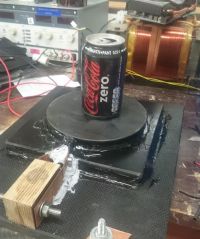
I broke the old coil. So new one was made. This beast is wound with two parallel 1x35mm Copper strips, insulated (between turns) with duct tape and held together with copious amount of car body adhesive and epoxy. The coil alone has so much birch plywood and copper in it that it weights over 5kg. It has 11 turns and measures about 8µH inductance. Other than being super annoying to wind there is another very good reason why this coil is so beefy...
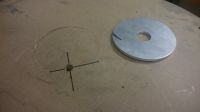
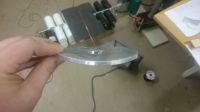
8700J test shot and results. Measured 90m/s speed which is really good for being fired at only 450V. As some of you may notice my capacitor bank is now quite a bit larger. And next time there may be 3 of those. I am seriously aiming for +1kJ projectile energies soon.
Kizmo, Tue Jan 19 2016, 11:38PM
Im back and its time to give a small hint about what will happen in 2016


I broke the old coil. So new one was made. This beast is wound with two parallel 1x35mm Copper strips, insulated (between turns) with duct tape and held together with copious amount of car body adhesive and epoxy. The coil alone has so much birch plywood and copper in it that it weights over 5kg. It has 11 turns and measures about 8µH inductance. Other than being super annoying to wind there is another very good reason why this coil is so beefy...


8700J test shot and results. Measured 90m/s speed which is really good for being fired at only 450V. As some of you may notice my capacitor bank is now quite a bit larger. And next time there may be 3 of those. I am seriously aiming for +1kJ projectile energies soon.
Re: High power EM projectile launcher
DerAlbi, Wed Jan 20 2016, 12:47PM
Interesting. I would like to know at what distance the effective acceleration happens. Care to do en experiment?
First of all we need to think about the same thing the same way. I see a ring launcher as a core-less transformer. Your secondary (ring) is short cirucited.
Due to the short circuit, the field, repells the disk. (so much for the basics)
So.. a basic property of a transformer is the coupling factor k. It tells you about the Leakage inductance and stuff.. the less leakage the more force on the secondary (ring).
So lets measure the coupling factor in dependence of the distance of the ring. When its goes close to 0 or 1/e or whatever we can call that particular distance the "effective range".
So lets measure the coupling. For that.. please build a small circuit:

Put your oscilloscope in singleshot mode. Capture the oscillation and measure its frequency.
Change the distance from the coil to the disc. Without disc you will observe the lowest oscillation frequency, and the closer the disc comes, the higher the frequency will become. If you use manual cursors, make sure you use multiple oscillations to minimize measurement errors.
The capacitor (1uF) must be the same for all measurements. If the frequency with the disc directly at the coil is way too high to seem reasonable (>500kHz) try to use 10uF then... but it must be a foil
Coupling factor is k = sqrt[ 1 - f_noDisk^2 / f_withDistk^2 ]
Oh.. and make sure you have at least one measurement without any disc close by. (should be the lowest frequency). The measurement precission of that frequency will impact the whole measurement.
DerAlbi, Wed Jan 20 2016, 12:47PM
Interesting. I would like to know at what distance the effective acceleration happens. Care to do en experiment?
First of all we need to think about the same thing the same way. I see a ring launcher as a core-less transformer. Your secondary (ring) is short cirucited.
Due to the short circuit, the field, repells the disk. (so much for the basics)
So.. a basic property of a transformer is the coupling factor k. It tells you about the Leakage inductance and stuff.. the less leakage the more force on the secondary (ring).
So lets measure the coupling factor in dependence of the distance of the ring. When its goes close to 0 or 1/e or whatever we can call that particular distance the "effective range".
So lets measure the coupling. For that.. please build a small circuit:

Put your oscilloscope in singleshot mode. Capture the oscillation and measure its frequency.
Change the distance from the coil to the disc. Without disc you will observe the lowest oscillation frequency, and the closer the disc comes, the higher the frequency will become. If you use manual cursors, make sure you use multiple oscillations to minimize measurement errors.
The capacitor (1uF) must be the same for all measurements. If the frequency with the disc directly at the coil is way too high to seem reasonable (>500kHz) try to use 10uF then... but it must be a foil

Coupling factor is k = sqrt[ 1 - f_noDisk^2 / f_withDistk^2 ]
Oh.. and make sure you have at least one measurement without any disc close by. (should be the lowest frequency). The measurement precission of that frequency will impact the whole measurement.
Re: High power EM projectile launcher
hen918, Wed Jan 20 2016, 06:01PM
Thanks for the formula DerAlbi, looks useful. You could use an LC meter for it though couldn't you?
hen918, Wed Jan 20 2016, 06:01PM
Thanks for the formula DerAlbi, looks useful. You could use an LC meter for it though couldn't you?
Re: High power EM projectile launcher
DerAlbi, Wed Jan 20 2016, 08:35PM
If a good one is available, yes. The problem is that with disc close by the L-Meter measures a "L parallel to a R" effectively. the smaller the R, the worse the resolution on L.. and any ESR will change the measurement too.
I havent done a K-measurement for a long time, so i never have done it with my LCR-Meter. Maybe its irrational fear on my side.. Anyway...
K is then sqrt(1-L_withDisc / L_noDisc)
DerAlbi, Wed Jan 20 2016, 08:35PM
If a good one is available, yes. The problem is that with disc close by the L-Meter measures a "L parallel to a R" effectively. the smaller the R, the worse the resolution on L.. and any ESR will change the measurement too.
I havent done a K-measurement for a long time, so i never have done it with my LCR-Meter. Maybe its irrational fear on my side.. Anyway...
K is then sqrt(1-L_withDisc / L_noDisc)
Re: High power EM projectile launcher
Kizmo, Fri Jan 22 2016, 07:40PM
And results are in from the first test. It turned out i did not have any paper at the workshop so i made a rough test with aviation magazines as spacers.
Here is the data. Shot #16 is the no disk shot
]disktest1.zip[/file]

Schematic worked as expected but i did add 1µF capacitor to the mosfet gate as debounce capacitor. Without it the switch bouncing was serious problem. Resonant frequency was very repeatable at each step so no problems there. I triggered the scope from mosfet gate so the data capture point in time was same every time.
Do we need higher resolution test?
EDIT: Swapped in fixed charts. EDIT2: Still wrong, argh!
Kizmo, Fri Jan 22 2016, 07:40PM
And results are in from the first test. It turned out i did not have any paper at the workshop so i made a rough test with aviation magazines as spacers.
Here is the data. Shot #16 is the no disk shot
]disktest1.zip[/file]

Schematic worked as expected but i did add 1µF capacitor to the mosfet gate as debounce capacitor. Without it the switch bouncing was serious problem. Resonant frequency was very repeatable at each step so no problems there. I triggered the scope from mosfet gate so the data capture point in time was same every time.
Do we need higher resolution test?
EDIT: Swapped in fixed charts. EDIT2: Still wrong, argh!
Re: High power EM projectile launcher
DerAlbi, Sat Jan 23 2016, 02:53AM
Really cool measurement result. Wouldnt have thought its working SO well ^_^
Its interesting to see that it seems to reach ~0 at the coil diameter (extrapolated). I wouldnt have thought that the field is expanding so far at all! What i see as disapointing here is that the best case coupling is only 0.63.
It would be intersting if you could add one solid plate directly below the coil. (I know its not working for a real shot due to mechanical reasons, but just for the sake of measurment)
My idea (based on a Post of BigBad in an other trhead) is that the field of the coil can not be pushed away from the disk, when its confined below. If the overall coupling increases that would be interesting. You basically repeat just the first measurement... your reference frequency should be close to 69kHz then and with the disk, its should even be higher.. hopefully in >150kHz-region.
DerAlbi, Sat Jan 23 2016, 02:53AM
Really cool measurement result. Wouldnt have thought its working SO well ^_^
Its interesting to see that it seems to reach ~0 at the coil diameter (extrapolated). I wouldnt have thought that the field is expanding so far at all! What i see as disapointing here is that the best case coupling is only 0.63.
It would be intersting if you could add one solid plate directly below the coil. (I know its not working for a real shot due to mechanical reasons, but just for the sake of measurment)
My idea (based on a Post of BigBad in an other trhead) is that the field of the coil can not be pushed away from the disk, when its confined below. If the overall coupling increases that would be interesting. You basically repeat just the first measurement... your reference frequency should be close to 69kHz then and with the disk, its should even be higher.. hopefully in >150kHz-region.
Re: High power EM projectile launcher
hen918, Sat Jan 23 2016, 11:30AM
You can improve coupling my milling or sanding off as much of the top insulation on the coil as possible. Obviously, if you take off too much you'll weaken the structure and it might break up.
hen918, Sat Jan 23 2016, 11:30AM
You can improve coupling my milling or sanding off as much of the top insulation on the coil as possible. Obviously, if you take off too much you'll weaken the structure and it might break up.
Re: High power EM projectile launcher
Kizmo, Sat Jan 23 2016, 11:52AM
Kizmo, Sat Jan 23 2016, 11:52AM
hen918 wrote ...
You can improve coupling my milling or sanding off as much of the top insulation on the coil as possible. Obviously, if you take off too much you'll weaken the structure and it might break up.
It might be possible but even now there is not a whole lot on top of the copper, about 3mm. Winding itself is 35mm tall.You can improve coupling my milling or sanding off as much of the top insulation on the coil as possible. Obviously, if you take off too much you'll weaken the structure and it might break up.
Re: High power EM projectile launcher
Uspring, Sat Jan 23 2016, 05:43PM
Nice measurement Kizmo
There is an expression for the force on the disk using your experimental values. The force is:
F = dL/dx * E/L,
dL/dx is the derivative of L wrt position of the disk, E the energy in the coil and L its inductance. If, e.g. we assume, that all 8700J get into the coil right at the beginning at position 1, we get:
F = 1uH/4.2mm * 8700J / 5uH = 400000N or about 40 tons.
At position 4, same energy assumed:
F = 0.262uH/4.2mm * 8700J / 6.5uH = 80000N or about 8 tons.
These values are ridiculously large. There are several reasons for that. Firstly, the cap energy takes some time to go into the coil. My guess is, that you have an oscillation frequency of about 300 Hz, This time will be at a quarter period, i.e. 0.8 ms. An e.g. 200g disk with such a force on it would have left the first 4mm within 40us. The assumption of all energy in the coil in the beginning is unrealistic. Secondly there is some resistance in the circuit, which reduces the current.
Mostly I think, it's still another effect. The disk is not a perfect conductor. Its DC resistance limits the current, which will reduce repulsion. The relevant quantity is here
2*pi*f*Ldisk/Rdisk
i.e. the ratio of its AC resistance to its DC resistance. If this ratio is much larger than 1, the disk DC resistance is negligible, i.e. it is a perfect conductor for our purposes. If it gets smaller than one, the current in it will drop and the repulsion also. Your k measurement was made at much larger frequencies than your real shots, so the disk will have in practice a much smaller resistance ratio, making it much less effective in terms of repulsion. I believe, these measurements should be made at the real frequencies. Dunno how to do that, since that would require your probably electrolytic cap bank be run with AC.
It's probably possible to work out the dynamics of the acceleration, if the time dependence of the current in the coil is known. The most important parameter is its DC resistance together with the cap ESR.
Uspring, Sat Jan 23 2016, 05:43PM
Nice measurement Kizmo

There is an expression for the force on the disk using your experimental values. The force is:
F = dL/dx * E/L,
dL/dx is the derivative of L wrt position of the disk, E the energy in the coil and L its inductance. If, e.g. we assume, that all 8700J get into the coil right at the beginning at position 1, we get:
F = 1uH/4.2mm * 8700J / 5uH = 400000N or about 40 tons.
At position 4, same energy assumed:
F = 0.262uH/4.2mm * 8700J / 6.5uH = 80000N or about 8 tons.
These values are ridiculously large. There are several reasons for that. Firstly, the cap energy takes some time to go into the coil. My guess is, that you have an oscillation frequency of about 300 Hz, This time will be at a quarter period, i.e. 0.8 ms. An e.g. 200g disk with such a force on it would have left the first 4mm within 40us. The assumption of all energy in the coil in the beginning is unrealistic. Secondly there is some resistance in the circuit, which reduces the current.
Mostly I think, it's still another effect. The disk is not a perfect conductor. Its DC resistance limits the current, which will reduce repulsion. The relevant quantity is here
2*pi*f*Ldisk/Rdisk
i.e. the ratio of its AC resistance to its DC resistance. If this ratio is much larger than 1, the disk DC resistance is negligible, i.e. it is a perfect conductor for our purposes. If it gets smaller than one, the current in it will drop and the repulsion also. Your k measurement was made at much larger frequencies than your real shots, so the disk will have in practice a much smaller resistance ratio, making it much less effective in terms of repulsion. I believe, these measurements should be made at the real frequencies. Dunno how to do that, since that would require your probably electrolytic cap bank be run with AC.
It's probably possible to work out the dynamics of the acceleration, if the time dependence of the current in the coil is known. The most important parameter is its DC resistance together with the cap ESR.
Re: High power EM projectile launcher
DerAlbi, Sat Jan 23 2016, 06:44PM
Where do you get those forumlas
Uspring, with the help of this formula one could easily just make an LTSpice circuit simulating the whole shot include efficiency and everything.
What i do currently not know is this: what inductance to use? Kizmo calculated the Inductance based on the resonant frequency. Based on 1uF +/-some%
So the L is wrong basically. The only relieable data we have is the coupling factor (its independend on C). Still i need a usefull L. Kizmo said before its 8uH, now its just 7.5uH..
Let me do some work. the excat value does not matter right now. Whats more annoying is the Curve-Fitting of k
DerAlbi, Sat Jan 23 2016, 06:44PM
Where do you get those forumlas

Uspring, with the help of this formula one could easily just make an LTSpice circuit simulating the whole shot include efficiency and everything.
What i do currently not know is this: what inductance to use? Kizmo calculated the Inductance based on the resonant frequency. Based on 1uF +/-some%
So the L is wrong basically. The only relieable data we have is the coupling factor (its independend on C). Still i need a usefull L. Kizmo said before its 8uH, now its just 7.5uH..
Let me do some work. the excat value does not matter right now. Whats more annoying is the Curve-Fitting of k
Re: High power EM projectile launcher
DerAlbi, Sat Jan 23 2016, 07:45PM
Wow. Its does indeed predict everything perfectly.
Sry i have only a LT-Spice simulation, pictures are useless. But we can play with the parameters within the simulation. It directly spits out Kizmos 90m/s end velocity (assuming 5mOhm overall ESR. The K-Factor function does not fit perfectly. There is a small missmatch right at the beginning where the missmatch actually hurts the most -.-).
I have commented to easier use.
]ringlauncher.zip[/file] [Edit: increased numerical stability]
I allways wanted to do such simulation for a coilgun. But in a multistage i didnt figure out how the variing coupling factors of the coils can be respected properly.
Compared to any FEM or whatever this is instantaneous .
.
DerAlbi, Sat Jan 23 2016, 07:45PM
Wow. Its does indeed predict everything perfectly.
Sry i have only a LT-Spice simulation, pictures are useless. But we can play with the parameters within the simulation. It directly spits out Kizmos 90m/s end velocity (assuming 5mOhm overall ESR. The K-Factor function does not fit perfectly. There is a small missmatch right at the beginning where the missmatch actually hurts the most -.-).
I have commented to easier use.
]ringlauncher.zip[/file] [Edit: increased numerical stability]
I allways wanted to do such simulation for a coilgun. But in a multistage i didnt figure out how the variing coupling factors of the coils can be respected properly.
Compared to any FEM or whatever this is instantaneous
 .
.Re: High power EM projectile launcher
Kizmo, Sat Jan 23 2016, 09:26PM
Thank you very much about all this interesting stuff! This is why i love this forum so deeply :)
Anyways, I made a first "next step" test fire today.
Parameters:
- 192g disk
- 31.6mF 1400V capacitor
- Capacitor charged to 920Volts 13.373kJ
Disk velocity measured 120m/s
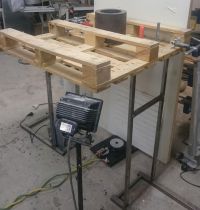

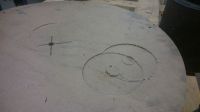
As you can see even the large steel piece i had on top of the improvised projectile stopper actually jumped up a bit. This is serious stuff right here :D
And im nowhere near done with this.
Kizmo, Sat Jan 23 2016, 09:26PM
Thank you very much about all this interesting stuff! This is why i love this forum so deeply :)
Anyways, I made a first "next step" test fire today.
Parameters:
- 192g disk
- 31.6mF 1400V capacitor
- Capacitor charged to 920Volts 13.373kJ
Disk velocity measured 120m/s




As you can see even the large steel piece i had on top of the improvised projectile stopper actually jumped up a bit. This is serious stuff right here :D
And im nowhere near done with this.
Re: High power EM projectile launcher
hen918, Sat Jan 23 2016, 10:43PM
Because the coupling decreases exponentially the further away the disk is from the coil, I've always thought that a shorter, higher current pulse (more voltage, less capacitance) would transfer more energy to the coil. Could you try at a higher voltage/current or wouldn't your switching device withstand it?
Thanks,
Henry
hen918, Sat Jan 23 2016, 10:43PM
Because the coupling decreases exponentially the further away the disk is from the coil, I've always thought that a shorter, higher current pulse (more voltage, less capacitance) would transfer more energy to the coil. Could you try at a higher voltage/current or wouldn't your switching device withstand it?
Thanks,
Henry
Re: High power EM projectile launcher
Kizmo, Sat Jan 23 2016, 10:45PM
I am moving towards using very large triggered spark gap switch so almost any voltage from 1kV and up will be doable. Any amount of current is doable.
Kizmo, Sat Jan 23 2016, 10:45PM
I am moving towards using very large triggered spark gap switch so almost any voltage from 1kV and up will be doable. Any amount of current is doable.
Re: High power EM projectile launcher
Uspring, Sun Jan 24 2016, 05:37PM
I had some fun playing around with your simulation. Cool and thank you, DerAlbi
I have no reference for the equations, so I derived them. If you're interested, I can PM or post a bit about this.
The max possible efficiency you can achieve is k². That would be for zero resistance in the coil and full current in it before the disk would begin to move. Put in other words: Say you have an energy E in the coil and you move the disk from a position where k²=0.25 to a position, where k²=0.20. You will then gain a kinetic energy of 0.05*E (the difference of the k²). For Kizmos setup k² is about 0.4, but the actual efficiency is at about 8%. One reason for lower efficiency is, that the disk has moved to considerably lower k² values before all the energy arrives in the coil.
The other reason is the ESR (and ESL).
Uspring, Sun Jan 24 2016, 05:37PM
I had some fun playing around with your simulation. Cool and thank you, DerAlbi

I have no reference for the equations, so I derived them. If you're interested, I can PM or post a bit about this.
The max possible efficiency you can achieve is k². That would be for zero resistance in the coil and full current in it before the disk would begin to move. Put in other words: Say you have an energy E in the coil and you move the disk from a position where k²=0.25 to a position, where k²=0.20. You will then gain a kinetic energy of 0.05*E (the difference of the k²). For Kizmos setup k² is about 0.4, but the actual efficiency is at about 8%. One reason for lower efficiency is, that the disk has moved to considerably lower k² values before all the energy arrives in the coil.
The other reason is the ESR (and ESL).
Re: High power EM projectile launcher
DerAlbi, Sun Jan 24 2016, 06:33PM
Well you obviously have a special feeling for such things - i admire that. I know that k is the shared flux and stuff but how it really affects energy transfer and why its k² and not k, I wouldnt dare to predict. But my speciality is circuit design, not the phyiscs behind it...
I am also not sure about my model... since the inductor changes i used the complete formula you stated once in the Coilgun-thread. But i dont know if that actually conserves or creates energy because it is going into mechanical work (due to changing k) so it feels wrong to care abut energy conservation in the changing inductor.
However the efficiency seems to be about right. Whats not right is the current waveform. Maybe Kizmo shares an oscilloscope picture of the current to show you what i mean. Edit: i remembered unspecified waveforms, that were maybe not even loaded with a disc. We have to wait for Kizmo to do measurements.
Honestlsy, i used LTSpice only as nonlinear time domain solver for your equations. i am not sure what i am actually simulating.
DerAlbi, Sun Jan 24 2016, 06:33PM
Well you obviously have a special feeling for such things - i admire that. I know that k is the shared flux and stuff but how it really affects energy transfer and why its k² and not k, I wouldnt dare to predict. But my speciality is circuit design, not the phyiscs behind it...
I am also not sure about my model... since the inductor changes i used the complete formula you stated once in the Coilgun-thread. But i dont know if that actually conserves or creates energy because it is going into mechanical work (due to changing k) so it feels wrong to care abut energy conservation in the changing inductor.
However the efficiency seems to be about right. Whats not right is the current waveform. Maybe Kizmo shares an oscilloscope picture of the current to show you what i mean. Edit: i remembered unspecified waveforms, that were maybe not even loaded with a disc. We have to wait for Kizmo to do measurements.
Honestlsy, i used LTSpice only as nonlinear time domain solver for your equations. i am not sure what i am actually simulating.
Re: High power EM projectile launcher
Uspring, Mon Jan 25 2016, 11:58AM
DerAlbi wrote:
phi = Integral(V*dt)
There will also be some flux generated from the current induced in the secondary but that affects only the current in the primary but not the validity of Faradays law. We can calculate the current in the primary by using the coupled primary inductance, i.e.
Icoupled = Integral(V*dt) / Lcoupled, so
Icoupled = phi / Lcoupled
The energy in the system is now
Ecoupled = 0.5 * Lcoupled * Icoupled^2
Note, that there is no flux through the secondary by Faradays law, since it is short circuited and therefore no voltage across it. Now move the secondary far away, so that it is not coupled anymore. The fluxes through both coils don't change during the movement, since there is no voltage across them. This implies a zero current in the secondary (no flux) and in the primary we have:
Iuncoupled = phi / Luncoupled
The energy in the system is after the movement:
Euncoupled = 0.5 * Luncoupled * Iuncoupled ^2
Putting these equations together, we get:
Euncoupled / Ecoupled = Lcoupled / Luncoupled
This allows us to calculated the electrical energy loss in the system from the change of the primary inductance. This loss is equal to the mechanical energy the disk acquires. With some more math the force can be derived. Applying the equation for k and the and the inductances, we get:
Euncoupled / Ecoupled = 1 - k^2
The theoretical max efficiency is then:
Eff = (Ecoupled-Euncoupled) / Ecoupled = k^2
Uspring, Mon Jan 25 2016, 11:58AM
DerAlbi wrote:
I know that k is the shared flux and stuff but how it really affects energy transfer and why its k² and not k, I wouldnt dare to predict.Imagine a primary coil and a short circuited secondary coupled to it. For simplicity assume them to be without resistance. Then apply some voltage V for some time to the primary. That will generate according to Faradays law a flux phi in it:
Yes, flux and Faradays law is involved.
phi = Integral(V*dt)
There will also be some flux generated from the current induced in the secondary but that affects only the current in the primary but not the validity of Faradays law. We can calculate the current in the primary by using the coupled primary inductance, i.e.
Icoupled = Integral(V*dt) / Lcoupled, so
Icoupled = phi / Lcoupled
The energy in the system is now
Ecoupled = 0.5 * Lcoupled * Icoupled^2
Note, that there is no flux through the secondary by Faradays law, since it is short circuited and therefore no voltage across it. Now move the secondary far away, so that it is not coupled anymore. The fluxes through both coils don't change during the movement, since there is no voltage across them. This implies a zero current in the secondary (no flux) and in the primary we have:
Iuncoupled = phi / Luncoupled
The energy in the system is after the movement:
Euncoupled = 0.5 * Luncoupled * Iuncoupled ^2
Putting these equations together, we get:
Euncoupled / Ecoupled = Lcoupled / Luncoupled
This allows us to calculated the electrical energy loss in the system from the change of the primary inductance. This loss is equal to the mechanical energy the disk acquires. With some more math the force can be derived. Applying the equation for k and the and the inductances, we get:
Euncoupled / Ecoupled = 1 - k^2
The theoretical max efficiency is then:
Eff = (Ecoupled-Euncoupled) / Ecoupled = k^2
I am also not sure about my model... since the inductor changes i used the complete formula you stated once in the Coilgun-thread. But i dont know if that actually conserves or creates energy because it is going into mechanical work (due to changing k) so it feels wrong to care abut energy conservation in the changing inductor.I'm not sure about this myself. The I*dL/dt term is sort of a back emf effect. My hunch is, that your simulation is correct. Anyway, since the efficiency is less than 10%, this effect is not so large, so the error due to a wrong simulation should also be not so large.
Re: High power EM projectile launcher
Kizmo, Mon Jan 25 2016, 01:01PM
Soon we will get much better velocity measurements! Im constructing laser and phototransistor based light gate setup where i can use oscilloscope for measuring time between two light beam crossings.
No more guess work from blurry 1200fps video.
Just for lolz we placed old and crappy basket ball on the disk to see if it would launch sky high. It didnt, the ball exploded and disk went pretty much straight through it Mighty bang!
Mighty bang!
Kizmo, Mon Jan 25 2016, 01:01PM
Soon we will get much better velocity measurements! Im constructing laser and phototransistor based light gate setup where i can use oscilloscope for measuring time between two light beam crossings.
No more guess work from blurry 1200fps video.
Just for lolz we placed old and crappy basket ball on the disk to see if it would launch sky high. It didnt, the ball exploded and disk went pretty much straight through it
 Mighty bang!
Mighty bang!Re: High power EM projectile launcher
Uspring, Tue Jan 26 2016, 04:40PM
If there are sightings of silvery disks flying around Northern Europe, I know now, where they come from.
Just be careful, the coil can explode.
Uspring, Tue Jan 26 2016, 04:40PM
If there are sightings of silvery disks flying around Northern Europe, I know now, where they come from.
Just be careful, the coil can explode.
Re: High power EM projectile launcher
DerAlbi, Tue Jan 26 2016, 05:35PM
Explode?? Shouldnt it just "implode" at best? (since its not the electrical weak point)
DerAlbi, Tue Jan 26 2016, 05:35PM
Explode?? Shouldnt it just "implode" at best? (since its not the electrical weak point)
Re: High power EM projectile launcher
hen918, Tue Jan 26 2016, 06:01PM
hen918, Tue Jan 26 2016, 06:01PM
DerAlbi wrote ...
Explode?? Shouldnt it just "implode" at best? (since its not the electrical weak point)
No, the huge magnetic fields act to push the windings apart. What you end up with cannot be called anything other than an explosion.Explode?? Shouldnt it just "implode" at best? (since its not the electrical weak point)
Re: High power EM projectile launcher
DerAlbi, Tue Jan 26 2016, 06:31PM
Aha Is that due to the disk then? Because all i know a coil it self contracts, but does not expand. And why would the force of the disk exceed the contraction?
Is that due to the disk then? Because all i know a coil it self contracts, but does not expand. And why would the force of the disk exceed the contraction?
DerAlbi, Tue Jan 26 2016, 06:31PM
Aha
 Is that due to the disk then? Because all i know a coil it self contracts, but does not expand. And why would the force of the disk exceed the contraction?
Is that due to the disk then? Because all i know a coil it self contracts, but does not expand. And why would the force of the disk exceed the contraction?Re: High power EM projectile launcher
dexter, Tue Jan 26 2016, 06:56PM
Newton's third law: For every action there is an equal and opposite re-action.
now the force acting upon the disk is not on all pints perpendicular to the disk, this mean there is a big vertical component and a small horizontal component. Both are felt by the coil in the opposite direction (Newton's third law) and depending on the coil/ disk geometry and power levels the coil might explode :)
dexter, Tue Jan 26 2016, 06:56PM
DerAlbi wrote ...
Aha Is that due to the disk then? Because all i know a coil it self contracts, but does not expand. And why would the force of the disk exceed the contraction?
Is that due to the disk then? Because all i know a coil it self contracts, but does not expand. And why would the force of the disk exceed the contraction?
Aha
 Is that due to the disk then? Because all i know a coil it self contracts, but does not expand. And why would the force of the disk exceed the contraction?
Is that due to the disk then? Because all i know a coil it self contracts, but does not expand. And why would the force of the disk exceed the contraction?Newton's third law: For every action there is an equal and opposite re-action.
now the force acting upon the disk is not on all pints perpendicular to the disk, this mean there is a big vertical component and a small horizontal component. Both are felt by the coil in the opposite direction (Newton's third law) and depending on the coil/ disk geometry and power levels the coil might explode :)
Re: High power EM projectile launcher
Kizmo, Tue Jan 26 2016, 06:59PM
 I am relatively careful. The coil is constructed in a way that i would be extremely impressed if it fails mechanically. Basicly it is wound with two parallel strips of copper sheet metal, 1.25mm by 35mm. Turn to turn insulation is done with duct tape and entire thing is bonded together with 2 component polyurethane based car body adhesive. The base is made from heavy duty birch plywood and the coil sits partially inside of a machined cavity.
I am relatively careful. The coil is constructed in a way that i would be extremely impressed if it fails mechanically. Basicly it is wound with two parallel strips of copper sheet metal, 1.25mm by 35mm. Turn to turn insulation is done with duct tape and entire thing is bonded together with 2 component polyurethane based car body adhesive. The base is made from heavy duty birch plywood and the coil sits partially inside of a machined cavity.
EDIT:
Here is a website that shows failed coil. Doesnt look exploded to me.

Kizmo, Tue Jan 26 2016, 06:59PM
Uspring wrote ...
If there are sightings of silvery disks flying around Northern Europe, I know now, where they come from.
Just be careful, the coil can explode.
If there are sightings of silvery disks flying around Northern Europe, I know now, where they come from.
Just be careful, the coil can explode.
 I am relatively careful. The coil is constructed in a way that i would be extremely impressed if it fails mechanically. Basicly it is wound with two parallel strips of copper sheet metal, 1.25mm by 35mm. Turn to turn insulation is done with duct tape and entire thing is bonded together with 2 component polyurethane based car body adhesive. The base is made from heavy duty birch plywood and the coil sits partially inside of a machined cavity.
I am relatively careful. The coil is constructed in a way that i would be extremely impressed if it fails mechanically. Basicly it is wound with two parallel strips of copper sheet metal, 1.25mm by 35mm. Turn to turn insulation is done with duct tape and entire thing is bonded together with 2 component polyurethane based car body adhesive. The base is made from heavy duty birch plywood and the coil sits partially inside of a machined cavity. EDIT:
Here is a website that shows failed coil. Doesnt look exploded to me.

Re: High power EM projectile launcher
klugesmith, Tue Jan 26 2016, 08:19PM
Hi guys. It's nice to see active discussions and confirmations about instrumentation and modeling of inductive-repulsion shooters.
If your work coil has a hole through the middle, like Albi's, then the rising projectile can pull a short, lightweight stick/string/ribbon. The tail end can produce a nice linear stroke to measure, without any tumbling etc., in a place easy to shield from the magnetic field pulse. Good place for some cheap optointerrupters. You could sum the outputs of 5 or 10 or 20 to make a stairstep waveform for your oscilloscope. Could get even better spatial resolution by going analog. Progressively expose a long, narrow light source or detector. Or move an illuminated spot or slit (or projectile) that's optically imaged onto a position-sensitive linear detector.

Is there any benefit from it being electrically triggered? People who shrink coins etc. generally migrate to mechanically triggered switches or spark gaps (non-sticking). Easy to match the performance of any trigatron or solid state switch, except for controlling the exact time of the shot.
klugesmith, Tue Jan 26 2016, 08:19PM
Hi guys. It's nice to see active discussions and confirmations about instrumentation and modeling of inductive-repulsion shooters.
Kizmo wrote ...
Soon we will get much better velocity measurements! Im constructing laser and phototransistor based light gate setup where i can use oscilloscope for measuring time between two light beam crossings.
Soon we will get much better velocity measurements! Im constructing laser and phototransistor based light gate setup where i can use oscilloscope for measuring time between two light beam crossings.
If your work coil has a hole through the middle, like Albi's, then the rising projectile can pull a short, lightweight stick/string/ribbon. The tail end can produce a nice linear stroke to measure, without any tumbling etc., in a place easy to shield from the magnetic field pulse. Good place for some cheap optointerrupters. You could sum the outputs of 5 or 10 or 20 to make a stairstep waveform for your oscilloscope. Could get even better spatial resolution by going analog. Progressively expose a long, narrow light source or detector. Or move an illuminated spot or slit (or projectile) that's optically imaged onto a position-sensitive linear detector.

Kizmo wrote ...
I am moving towards using very large triggered spark gap switch so almost any voltage from 1kV and up will be doable. Any amount of current is doable.
I am moving towards using very large triggered spark gap switch so almost any voltage from 1kV and up will be doable. Any amount of current is doable.
Is there any benefit from it being electrically triggered? People who shrink coins etc. generally migrate to mechanically triggered switches or spark gaps (non-sticking). Easy to match the performance of any trigatron or solid state switch, except for controlling the exact time of the shot.
Re: High power EM projectile launcher
Kizmo, Tue Jan 26 2016, 08:48PM
The acceleration is so violent i have little to no hope that anything attached to the disk would stay on.
And reason for going to triggered gap is it being simple in mechanical mind. At these energy levels magnetic forces and electrode wear are serious. Being relatively low voltage switching it makes the switch erosion even worse. My new triggered gap design uses brass electrodes since brass turns instantly to vapor instead of spattering molten metal blobs everywhere covering my insulator materials with conductive particles.
Just some time ago i realized that commercial spark gap have shot life depending on capacitor charge in Coulombs, not energy or peak currents. And this is where it kicks my butt:
My setup is 31.6 mF at 1450 V
E = 0.5 * C * U^2
0.5 * 31.6*10^-3 F * 1450V^2 = 33220 J
But charge in Coulombs is C * V
31.6*10^-3 F * 1450 V = 45.82 C
It would have to be *really* large commercial spark gap to have charge transfer rating larger than that. If my capacitor bank was lets say 50kV it would be a whole lot easier to any kind of mechanical or spark gap switching:
33.22kJ at 50kV equals about 26.58µF of capacitance.
26.58*10^-6 F * 50000 V = 1.33 C
See the difference?
Kizmo, Tue Jan 26 2016, 08:48PM
The acceleration is so violent i have little to no hope that anything attached to the disk would stay on.
And reason for going to triggered gap is it being simple in mechanical mind. At these energy levels magnetic forces and electrode wear are serious. Being relatively low voltage switching it makes the switch erosion even worse. My new triggered gap design uses brass electrodes since brass turns instantly to vapor instead of spattering molten metal blobs everywhere covering my insulator materials with conductive particles.
Just some time ago i realized that commercial spark gap have shot life depending on capacitor charge in Coulombs, not energy or peak currents. And this is where it kicks my butt:
My setup is 31.6 mF at 1450 V
E = 0.5 * C * U^2
0.5 * 31.6*10^-3 F * 1450V^2 = 33220 J
But charge in Coulombs is C * V
31.6*10^-3 F * 1450 V = 45.82 C
It would have to be *really* large commercial spark gap to have charge transfer rating larger than that. If my capacitor bank was lets say 50kV it would be a whole lot easier to any kind of mechanical or spark gap switching:
33.22kJ at 50kV equals about 26.58µF of capacitance.
26.58*10^-6 F * 50000 V = 1.33 C
See the difference?

Re: High power EM projectile launcher
Uspring, Wed Jan 27 2016, 08:53AM
DerAlbi wrote:
Uspring, Wed Jan 27 2016, 08:53AM
DerAlbi wrote:
Explode?? Shouldnt it just "implode" at best?Depends. Parallel conductors with currents going in the same direction are attracted, opposite currents are repelled. For a helical coil, that implies an axial contraction and a radial repulsion. Adjacent conductors in a spiral coil like Kizmos will be attracted to each other, but they will be repelled by the conductors on the other side of the coil. It might well be, that the forces are of the same order of magnitude as those on the disk, i.e. several tons.
Re: High power EM projectile launcher
Signification, Wed Jan 27 2016, 12:26PM
Interesting...shot life dependent upon "only?" cap charge! Do you have an equation or reference to calculations?
At an auction, I picked up four (4) never-used brass HEMIspheres: 3" in dia. and 2lbs each with a 4" low R electrode, into which screwed 12" bars (these were magnetic and I will keet then out of the circuit. They were outfitted with what looked like a brass orcordian--my guess--an air trigger for slamming the electrodes together. To bad the guy had started peeling them off
I am planning to use them on my quarter shrinker that currently consists of two 70uF @ 12kv in parallel--I use only 10kV, so that comes to E=7kJ. Q=CV=(140EE-6)*10kV=1.4 Coulombs (close to your 1.33Q).
I remember getting some not-to-bad results with these caps in series...forgot the voltage, but using 10kV here (Which preserves the same 7kJ energy, that required 20kV@ the series 35uF). That's (35x10^-6)*(20kV)=0.7Q. 1/2 of the parallel (low V) arrangement--same energy...and capacitor pair...don't know about Ip.
The best part--I got all this bras for 25 cents
Does anybody know how this kind of "low surface area" power switching compares with the much larger contact area on those electrodes that slam large 'flat' areas together? Maybe they (spheres) were intended to be used in a vacuum or gaseous environment??? BTW: Those loud discharge caps from the disposable cameras barely make a "pop" when shorted through these spheres!!!
Signification, Wed Jan 27 2016, 12:26PM
Kizmo wrote ...
The acceleration is so violent i have little to no hope that anything attached to the disk would stay on.
And reason for going to triggered gap is it being simple in mechanical mind. At these energy levels magnetic forces and electrode wear are serious. Being relatively low voltage switching it makes the switch erosion even worse. My new triggered gap design uses brass electrodes since brass turns instantly to vapor instead of spattering molten metal blobs everywhere covering my insulator materials with conductive particles.
Just some time ago i realized that commercial spark gap have shot life depending on capacitor charge in Coulombs, not energy or peak currents. And this is where it kicks my butt:
My setup is 31.6 mF at 1450 V
E = 0.5 * C * U^2
0.5 * 31.6*10^-3 F * 1450V^2 = 33220 J
But charge in Coulombs is C * V
31.6*10^-3 F * 1450 V = 45.82 C
It would have to be *really* large commercial spark gap to have charge transfer rating larger than that. If my capacitor bank was lets say 50kV it would be a whole lot easier to any kind of mechanical or spark gap switching:
33.22kJ at 50kV equals about 26.58µF of capacitance.
26.58*10^-6 F * 50000 V = 1.33 C
See the difference?
The acceleration is so violent i have little to no hope that anything attached to the disk would stay on.
And reason for going to triggered gap is it being simple in mechanical mind. At these energy levels magnetic forces and electrode wear are serious. Being relatively low voltage switching it makes the switch erosion even worse. My new triggered gap design uses brass electrodes since brass turns instantly to vapor instead of spattering molten metal blobs everywhere covering my insulator materials with conductive particles.
Just some time ago i realized that commercial spark gap have shot life depending on capacitor charge in Coulombs, not energy or peak currents. And this is where it kicks my butt:
My setup is 31.6 mF at 1450 V
E = 0.5 * C * U^2
0.5 * 31.6*10^-3 F * 1450V^2 = 33220 J
But charge in Coulombs is C * V
31.6*10^-3 F * 1450 V = 45.82 C
It would have to be *really* large commercial spark gap to have charge transfer rating larger than that. If my capacitor bank was lets say 50kV it would be a whole lot easier to any kind of mechanical or spark gap switching:
33.22kJ at 50kV equals about 26.58µF of capacitance.
26.58*10^-6 F * 50000 V = 1.33 C
See the difference?

Interesting...shot life dependent upon "only?" cap charge! Do you have an equation or reference to calculations?
At an auction, I picked up four (4) never-used brass HEMIspheres: 3" in dia. and 2lbs each with a 4" low R electrode, into which screwed 12" bars (these were magnetic and I will keet then out of the circuit. They were outfitted with what looked like a brass orcordian--my guess--an air trigger for slamming the electrodes together. To bad the guy had started peeling them off

I am planning to use them on my quarter shrinker that currently consists of two 70uF @ 12kv in parallel--I use only 10kV, so that comes to E=7kJ. Q=CV=(140EE-6)*10kV=1.4 Coulombs (close to your 1.33Q).
I remember getting some not-to-bad results with these caps in series...forgot the voltage, but using 10kV here (Which preserves the same 7kJ energy, that required 20kV@ the series 35uF). That's (35x10^-6)*(20kV)=0.7Q. 1/2 of the parallel (low V) arrangement--same energy...and capacitor pair...don't know about Ip.
The best part--I got all this bras for 25 cents

Does anybody know how this kind of "low surface area" power switching compares with the much larger contact area on those electrodes that slam large 'flat' areas together? Maybe they (spheres) were intended to be used in a vacuum or gaseous environment??? BTW: Those loud discharge caps from the disposable cameras barely make a "pop" when shorted through these spheres!!!
Re: High power EM projectile launcher
Kizmo, Wed Jan 27 2016, 12:57PM
Here is one app note:
 (This is why i chose brass)
(This is why i chose brass)
Here is my set of electrodes. I call this gap as the "final solution"
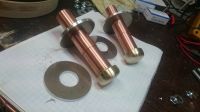
Kizmo, Wed Jan 27 2016, 12:57PM
Signification wrote ...
Interesting...shot life dependent upon "only?" cap charge! Do you have an equation or reference to calculations?
Interesting...shot life dependent upon "only?" cap charge! Do you have an equation or reference to calculations?
Here is one app note:

app note wrote ...
Lifetime
The lifetime of the triggered gap can be approximated
in terms of the cumulative charge, in coulombs (Q),
that can be passed through the device without
changing its main static breakdown voltage by more
than 20 percent. Expressing the height of the current
pulse in amperes and the duration in seconds, the
area under the pulse is the coulomb of charge
contained in it.
Example 1:
A triggered gap is required to pass a 20,000 peak amp
pulse having a 10µs pulse half-width. Approximating
the pulse shape by a triangle, the charge contained in
the pulse is:
q = 20,000 amps x 10-5 sec = 0.2 coulombs
If the Coulomb Rating (Q) is given as 100 coulombs,
the life under these conditions is approximately:
Life = Q/q = 100/0.2 = 500 discharges
Example 2:
A 10kV main static breakdown triggered gap must
dump a 2.0µF capacitor charged to 8kV. The charge
stored in the capacitor is:
q = CV = 2.0 x 10-6 farads x 8,000 Volts
q = 0.016 coulombs
If the Coulomb Rating (Q) is given as 100 coulombs,
the life under these conditions is approximately:
Life = Q/q = 100/0.016 = 6,250 discharges
And research paper: Lifetime
The lifetime of the triggered gap can be approximated
in terms of the cumulative charge, in coulombs (Q),
that can be passed through the device without
changing its main static breakdown voltage by more
than 20 percent. Expressing the height of the current
pulse in amperes and the duration in seconds, the
area under the pulse is the coulomb of charge
contained in it.
Example 1:
A triggered gap is required to pass a 20,000 peak amp
pulse having a 10µs pulse half-width. Approximating
the pulse shape by a triangle, the charge contained in
the pulse is:
q = 20,000 amps x 10-5 sec = 0.2 coulombs
If the Coulomb Rating (Q) is given as 100 coulombs,
the life under these conditions is approximately:
Life = Q/q = 100/0.2 = 500 discharges
Example 2:
A 10kV main static breakdown triggered gap must
dump a 2.0µF capacitor charged to 8kV. The charge
stored in the capacitor is:
q = CV = 2.0 x 10-6 farads x 8,000 Volts
q = 0.016 coulombs
If the Coulomb Rating (Q) is given as 100 coulombs,
the life under these conditions is approximately:
Life = Q/q = 100/0.016 = 6,250 discharges
 (This is why i chose brass)
(This is why i chose brass)Here is my set of electrodes. I call this gap as the "final solution"


Re: High power EM projectile launcher
Kizmo, Tue Feb 09 2016, 07:58AM
Updated main post, new velocity measurement thing is finally ready to go!
Kizmo, Tue Feb 09 2016, 07:58AM
Updated main post, new velocity measurement thing is finally ready to go!
Re: High power EM projectile launcher
klugesmith, Wed Feb 10 2016, 02:56AM
Nice work there. Can't wait to see your velocity measurements. Are you planning to try laser beams in the first few mm or cm of motion, to refine the linear induction motor model?
Who knows what's inside regular ballistic chronographs? Are the background strips retroreflective? Are the optical sensor signals AC-coupled?

Remember when high-speed photography didn't mean high frame-rate videography?
Your launcher appears to be very robust and repeatable.
Got any interest in playing with microsecond flashlamps, taking one variably-delayed picture per shot, to study the acceleration & even make movies? Or multiple flashes to get multiple time points per shot?
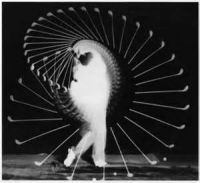
klugesmith, Wed Feb 10 2016, 02:56AM
Nice work there. Can't wait to see your velocity measurements. Are you planning to try laser beams in the first few mm or cm of motion, to refine the linear induction motor model?
Who knows what's inside regular ballistic chronographs? Are the background strips retroreflective? Are the optical sensor signals AC-coupled?

Remember when high-speed photography didn't mean high frame-rate videography?
Your launcher appears to be very robust and repeatable.
Got any interest in playing with microsecond flashlamps, taking one variably-delayed picture per shot, to study the acceleration & even make movies? Or multiple flashes to get multiple time points per shot?

Re: High power EM projectile launcher
zrg, Mon Jun 20 2016, 04:00AM
I could suggest something from the USSR old stock things (not sure if similar devices are available worldwide):

This is IRT-6 (ИРТ-6), mercury pulse valve, and it commutates up to 30 Сoulombs at up to 25 kV and 100kA (numbers are manufacturer rated, so I think it can be pushed 1.5x times up from that). Unfortunately I need mine for my own can crusher, but this is the ultimate solution to all commutation, brass evaporation, loud sounds and other problems with high energy capacitor banks. If you manage to find someone in Russian Internet who sells and ships one to you (which may be tricky since it has ~500g of liquid mercury inside), I highly recommend it.
zrg, Mon Jun 20 2016, 04:00AM
I could suggest something from the USSR old stock things (not sure if similar devices are available worldwide):

This is IRT-6 (ИРТ-6), mercury pulse valve, and it commutates up to 30 Сoulombs at up to 25 kV and 100kA (numbers are manufacturer rated, so I think it can be pushed 1.5x times up from that). Unfortunately I need mine for my own can crusher, but this is the ultimate solution to all commutation, brass evaporation, loud sounds and other problems with high energy capacitor banks. If you manage to find someone in Russian Internet who sells and ships one to you (which may be tricky since it has ~500g of liquid mercury inside), I highly recommend it.
Re: High power EM projectile launcher
Patrick, Tue Jun 21 2016, 07:19PM
500g of mercury ! the Russians make all the fun stuff.
Patrick, Tue Jun 21 2016, 07:19PM
zrg wrote ...
....(which may be tricky since it has ~500g of liquid mercury inside), I highly recommend it.
....(which may be tricky since it has ~500g of liquid mercury inside), I highly recommend it.
500g of mercury ! the Russians make all the fun stuff.
Print this page
